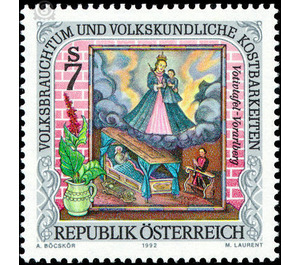folklore - Austria / II. Republic of Austria 1992 - 7 Shilling
Theme: Art & Culture
| Country | Austria / II. Republic of Austria |
| Issue Date | 1992 |
| Face Value | 7.00 |
| Color | multi-colored grey |
| Printing Type | combination printing |
| Stamp Type | Commemorative |
| Item Type | Stamp |
| Chronological Issue Number | 1418 |
| Chronological Chapter | OOS-OE2 |
| SID | 415811 |
| In 61 Wishlists | |
The Vener Chapel "To Our Lady", popularly called "Venser Bild", is located in the parish of the municipality Vandans in the valley Montafon in Vorarlberg. In 1613 the plague raged in Vandans and under the impression of this distress, a farmer's wife named Maria Pleng vowed to have a chapel built in honor of the Mother of God, Saint Mary, and the plague patron, Saint Sebastian, when the district of Vens spared from the plague. In fact, Vens was spared the plague and the chapel was subsequently built. It became a much-visited place of worship, enlarged in 1697, and then equipped with two bells. In the course of the founding of the Sebastian Brotherhood in 1713, the chapel was enlarged by the cultivation of a country house. Since 1938, it has been set up for the holding of Holy Masses on the three stylish baroque altars, which are celebrated there once a week during the summer months.


